
Anostostomatidae is a family of insects in the order Orthoptera, widely distributed in the southern hemisphere. It is named Mimnermidae or Henicidae in some taxonomies, and common names include king crickets in Australia and South Africa, and wētā in New Zealand. Prominent members include the Parktown prawn of South Africa, and the giant wētā of New Zealand.

Dictyoptera is an insect superorder that includes two extant orders of polyneopterous insects: the order Blattodea and the order Mantodea (mantises). All modern Dictyoptera have short ovipositors and typically lay oothecae. The oldest fossils of Dictyoptera from the Late Carboniferous, referred to as "roachoids" have long ovipositors and did not lay oothecae. The oldest modern oothecae-laying dictyopterans date to the Late Triassic.

Meganeura is a genus of extinct insects from the Late Carboniferous. They resembled and are related to the present-day dragonflies and damselflies, and were predatory, with their diet mainly consisting of other insects. The genus belongs to the Meganeuridae, a family including other similarly giant dragonfly-like insects ranging from the Late Carboniferous to Middle Permian. With single wing length reaching 32 centimetres (13 in) and a wingspan about 65–75 cm (2.13–2.46 ft), M. monyi is one of the largest-known flying insect species.

The Trachypachidae are a family of beetles that generally resemble small ground beetles, but that are distinguished by the large coxae of their rearmost legs. There are only six known extant species in the family, with four species of Trachypachus found in northern Eurasia and northern North America, and two species of Systolosoma in Chile and Argentina. They were much more diverse in the past, with dozens of described species from the Mesozoic.

The Caelifera are a suborder of orthopteran insects. They include the grasshoppers and grasshopper-like insects, as well as other superfamilies classified with them: the ground-hoppers (Tetrigoidea) and pygmy mole crickets (Tridactyloidea). The latter should not be confused with the mole crickets (Gryllotalpidae), which belong to the other Orthopteran sub-order Ensifera.
The most recent understanding of the evolution of insects is based on studies of the following branches of science: molecular biology, insect morphology, paleontology, insect taxonomy, evolution, embryology, bioinformatics and scientific computing. It is estimated that the class of insects originated on Earth about 480 million years ago, in the Ordovician, at about the same time terrestrial plants appeared. Insects are thought to have evolved from a group of crustaceans. The first insects were landbound, but about 400 million years ago in the Devonian period one lineage of insects evolved flight, the first animals to do so. The oldest insect fossil has been proposed to be Rhyniognatha hirsti, estimated to be 400 million years old, but the insect identity of the fossil has been contested. Global climate conditions changed several times during the history of Earth, and along with it the diversity of insects. The Pterygotes underwent a major radiation in the Carboniferous while the Endopterygota underwent another major radiation in the Permian.

Sharovipteryx is a genus of early gliding reptiles containing the single species Sharovipteryx mirabilis. It is known from a single fossil and is the only glider with a membrane surrounding the pelvis instead of the pectoral girdle. This lizard-like reptile was found in 1965 in the Madygen Formation, Dzailauchou, on the southwest edge of the Fergana Valley in Kyrgyzstan, in what was then the Asian part of the U.S.S.R. dating to the middle-late Triassic period. The Madygen horizon displays flora that put it in the Upper Triassic. An unusual reptile, Longisquama, was also found there.
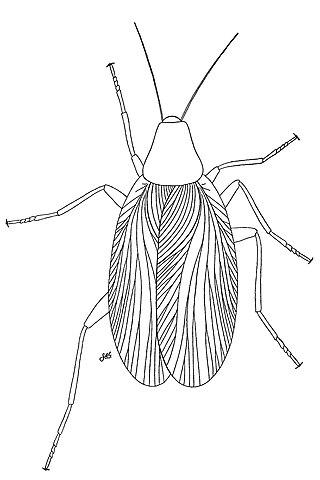
"Roachoids", also known as "Roachids", "Blattoids" or Eoblattodea, are members of the stem group of Dictyoptera. They generally resemble cockroaches, but most members, unlike modern dictyopterans, have generally long external ovipositors, and are thought not to have laid ootheca like modern dictyopterans.
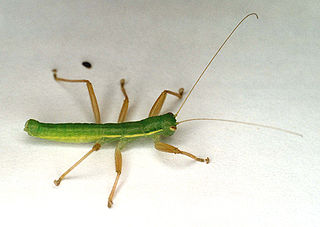
Notoptera, also known as Xenonomia, is a clade of insects belonging to Polyneoptera. It contains two living groups, Mantophasmatidae (gladiators) native to southern Africa, and Grylloblattidae native to cold montane environments in the Northern Hemisphere. Both groups are wingless.
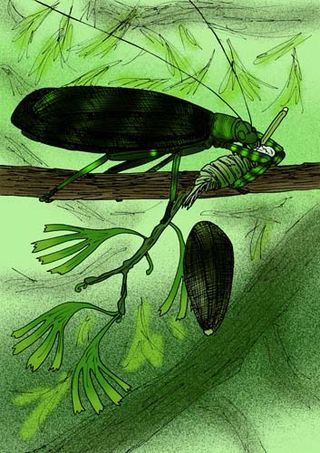
Titanoptera is an extinct order of neopteran insects from late Carboniferous to Triassic periods. Titanopterans were very large in comparison with modern insects, some having wingspans of up to 36 centimetres (14 in) or even 40 centimetres (16 in).

Coxoplectoptera or "chimera wings" is an extinct order of stem-group mayflies containing one family, Mickoleitiidae. Together with mayflies (Ephemeroptera), Coxoplectoptera are assigned to the clade Heptabranchia.
Kyrgyzsaurus is an extinct genus of drepanosaurid reptile known from the Triassic of southwestern Kyrgyzstan. It was discovered in the Madygen Formation.

The Madygen Formation is a Middle–Late Triassic (Ladinian–Carnian) geologic formation and lagerstätte in the Batken and Osh Regions of western Kyrgyzstan, with minor outcrops in neighboring Tajikistan and Uzbekistan. The conglomerates, sandstones and mudstones of the 560 m (1,840 ft) thick formation were deposited in terrestrial lacustrine, alluvial, fluvial and deltaic environments.
Fayolia is a genus of fossil egg capsule, widely thought to have been produced by xenacanths. The egg is elongate and tapers towards both ends, and surrounded by helically twisted collarettes, with one end having a tendril.
The Hassberge Formation is a geologic formation in Bavaria, Germany. It preserves fossils dating back to the Carnian stage of the Triassic period.
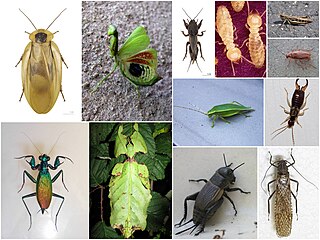
The cohort Polyneoptera is one of the major groups of winged insects, comprising the Orthoptera and all other neopteran insects believed to be more closely related to Orthoptera than to any other insect orders. They were formerly grouped together with the Palaeoptera and Paraneoptera as the Hemimetabola or Exopterygota on the grounds that they have no metamorphosis, the wings gradually developing externally throughout the nymphal stages. Many members of the group have leathery forewings (tegmina) and hindwings with an enlarged anal field (vannus).

Elcanidae are an extinct family of Mesozoic and early Cenozoic orthopterans. Members of the family are distinguished by the presence of spurs on the distal part of the metatibia, unique among orthopterans, these have been suggested to have been used for controlling gliding, swimming aids, or for jumping on water. The group combines characteristics from both major groups of orthopterans, with long antennae and nymphal morphology similar to Ensifera, but with wing venation and adult morphology more similar to Caelifera. Elcanidae is part of Elcanoidea, which is thought to have diverged from living orthopterans by the beginning of the Permian, around 300 million years ago. The family also includes Permelcanidae, known from the Early-Late Permian. The relationship of Elcanoidea to Ensifera and Caelifera is currently unresolved. Elcanids are known from the Late Triassic to Paleocene of Eurasia, North and South America. Some members of the group exhibited aposematic coloration. They are thought to have been herbivorous.
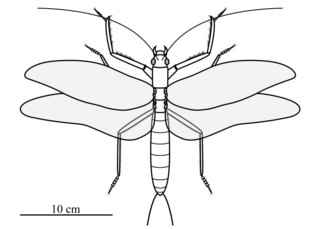
Clatrotitan is an extinct genus of titanopteran insect, known from the Triassic of Australia. It is originally described from a species, C. andersoni, then later study considered that Mesotitan scullyi as species of Clatrotitan too. But another study synonymized Mesotitan and Clatrotitan. A study in 2021 proposed to keep the two genera Clatrotitan and Mesotitan separated. C. andersoni had a large forewing, which was 13.8 centimetres (5.4 in) long.
Geinitziidae is an extinct family of polyneopteran insects, known from the Permian to Cretaceous. They are currently considered to be members "Grylloblattida" a poorly defined group of extinct insects thought to be related to modern ice crawlers (Grylloblattidae). Other authors place them in the extinct order Reculida. Unlike modern ice crawlers, which are wingless, they had large wings, bearing a superficial resemblance to cockroaches, and are thought to have been day-active above ground predators.

The Amisan Formation (Korean: 아미산층) is an Late Triassic geologic formation in South Korea. Fossil records from this formation include plants, insects, and fish remains.



















